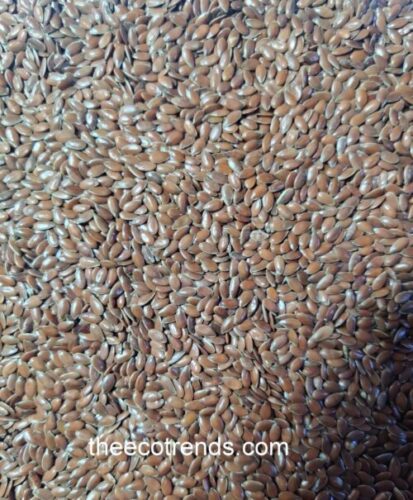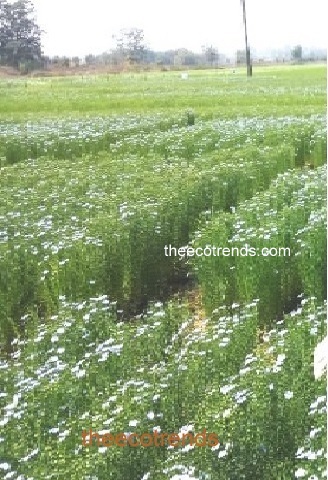Importance of Linseeds
Tisi or the Flax Plant is also known as Linseed.
It is botanically known as Linum usitatissimum and it belongs to the taxonomic family Linaceae.
It is cultivated as oilseed and fibre crop in many parts of the world including India.
Tisi or the linseed is reported to contain 20% protein, 37% fat, and 28% carbohydrate. It contains sufficient amount of Omega-3Fatty acid also, which is good for removing Cholesterol.
It is also useful for the health of heart and also for rheumatic arthritis.
It also contains lignan which is anti-cancer.
Due to these properties linseed is in good demand in the global market. The farming of linseed has high prospects in view of its market value and market demand.
Scientists are of the opinion that the farming of linseed is very profitable if High Yielding varieties are grown with scientific methods adopting proper crop management practices.
Linseed Farming in Jharkhand

The farming of linseed is becoming highly popular in Jharkhand state due to its multi dimensional medicinal properties and high demands in markets.
During the year 200 it was cultivated in about 7ha. As per reports of the Department of Agriculture it covered 40,000 ha up to the year 2018-19.
In a review meeting of scientists of 65 Agriculture Centres of Bihar and Jharkhand, it was reported that there is 18% increase in the area of cultivation of linseed and 20 to 25 % increase in its production.
The varieties of linseed developed by Birsa Agriculture University Ranchi have been liked by farmers of Jharkhand and Bihar.
Its two varieties that have been developed by BAU Ranchi namely Divya and Priyam are cultivated in irrigated and non-irrigated areas respectively.
Despite Divya and Priyam, Shekhar has also been taken into account by farmers. Shekhar is preferred for irrigated areas.
The production capacities of Divya and Priyam are 12 to 16 Q per ha. The yield of Shekhar has been 7 to 9 Q per ha.
Cultivation of linseed in Jharkhand is popular since ancient period. It was due to less production and profit in early period that farmers did not take sufficient interest in the linseed cultivation.
As per estimates about 1416 lakh ha area of paddy cultivation remained empty in the early periods. Farmers can take sufficient profit by sowing linseeds in the empty fields in less moisture and less irrigation after harvesting paddy. This year the fields are rather moister due to late rains.
As mentioned earlier, BAU has developed two varieties of Linseeds under All India Integrated Research of ICAR. These two varieties are Divya and Priyam.
The Central Seed Certification Agency of India has recommended these two varieties for sowing in Jharkhand.
About 3.1 Quintals of reproductive seeds have been supplied to other states having similar climatic conditions to fulfill the national requirement.
National Seed Corporation has also been supplied 3.1 quintals of linseeds to produce reproductive seeds.
Recently, the University conducted seed production Programme in about 10 acres of land. New researches are continued in Soil Sciences and Crop Sciences in relation to these crop varieties.
The First Line Cultivation Programme in different districts of Jharkhand was conducted during the previous year. The research estimation in the 6 acres of land of the University to produce reproductive seeds and the research estimation on 150 genotypes are continued.
The transfer of linseed production techniques to the fields of farmers has helped hundreds of tribal farmers to increase their income through linseed cultivation.
The appropriate time of linseed farming in Jharkhand is from 15 October to 15 November.
The distance between lines for linseed production should be 30 cm.
From 20 to 25 kg of seeds per ha of land are required.
About 20 to 25 kg of Nitrogenous fertilizers, 20 kg of Phosphorus, 20 kg of Potassium and 20 kg of Sulphur fertilizers are recommended in un-irrigated conditions in one hectare of land.
In irrigated conditions 80 kg of Nitrogenous fertilizers, 30 kg of Phosphorus, 20 kg of Potassium and 20 kg of Sulphur fertilizers are recommended in one hectare of land for the linseed cultivation.
Weeding process is essential after one month of sowing the seeds into the fields.
These varieties need a total of 125 to 130 days.
Their seeds contain 35 to 41 percent of oil.
These varieties of linseeds are good for mixed cropping with gram, masoor (Lentil), potatoes, French-beans etc.
The farming of linseeds in view of Nutritional Safety is a powerful option to double the income of farmers in Jharkhand.
Key Words: linseed, farming, Jharkhand, Divya, Priyam, Nutritional Safety




